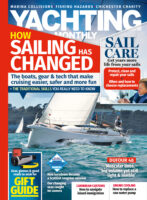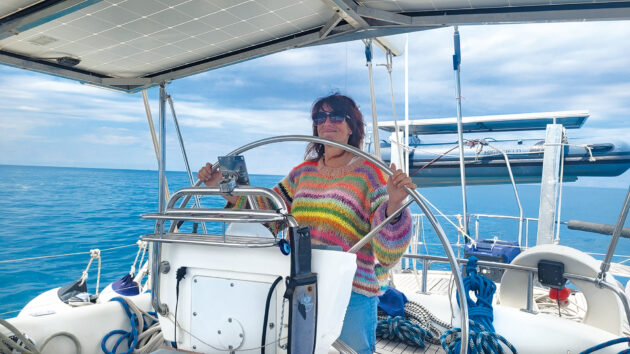Crewing on other boats is a great way to explore new places, sail new boats and meet new people, but it isn’t without its pitfalls, says Anna Bingham
We’re all different. We have diverse aims, agendas and ways of getting there. All of them are right. So, what holds people back? A large number get their Day Skipper with the sole intention of bareboat chartering in the Med.
That’s fine, but it may not lead to much further progression. Some people go sailing to race, cross the Channel, or gain a qualification. Or being able to skipper your own boat may simply be a way to reduce the cost of holidays, improve safety, to get the exercise of being on board, or even provide social or even dating opportunities.
I feel a strong desire to progress in my sailing – to become a better all-round sailor, and to feel more confident in my skippering. Having bought a Nicholson 32 with my partner Dan and friend Aly, I’ve realised that I have fallen into a sailing routine of pottering on short trips around the same stretch of Cornish coastline that’s become too comfortable and now lacks enough of a challenge.
The diagnosis
Having sailed my own boat for a few years, I was struggling to gain wider experience and confidence, outside of the few usual harbours we visit, so I am on a long-term mission to broaden my sailing horizons and become a better sailor.
So, my objective is to make the crossing to Spain, across Biscay, using writing as my justification. As part of that, I’ve learned to dinghy sail, got my Day Skipper ticket, and now I want to try sailing in different places, with other people, on different boats.
There are an amazing number of people out there looking for crew, some for free, some that you’ll have to pay thousands for, and everything in-between. Of course, I could sign up for transatlantic yacht deliveries to really build some miles, but I thought I’d start with some more casual crewing.
When the time came to start looking, I found the range of options and variables quite bewildering, and at the back of my mind was whether I was going to find people to sail with who I liked, and who liked me, who I could trust and feel safe with at sea. Above all, I wanted to learn as much as I could.
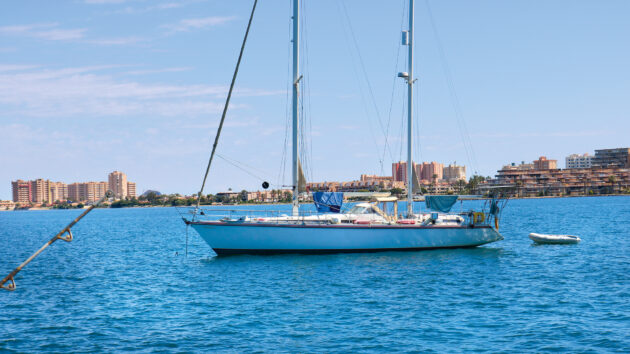
Anchoring up next to cruising friends that Jon and Ang had not seen for five years
Test flight
Is it me or has air travel reverted back to something that’s a bit too casual? The poor girl behind me projectile vomits mid-flight. ‘Oh nice!’ says the stewardess – no wet wipes or sympathy on offer. But at less than the cost of petrol to Portsmouth I’m not complaining.
I just hope my skipper is a bit kinder, that’s all. ‘Being nice’ was written at the top of my checklist when I searched for crewing opportunities, together with ‘no Casanovas, drinkers, or know-it-alls’ written opposite. As a female, I also had concerns about safety and sexual harassment when doing the marine equivalent of hitch-hiking.
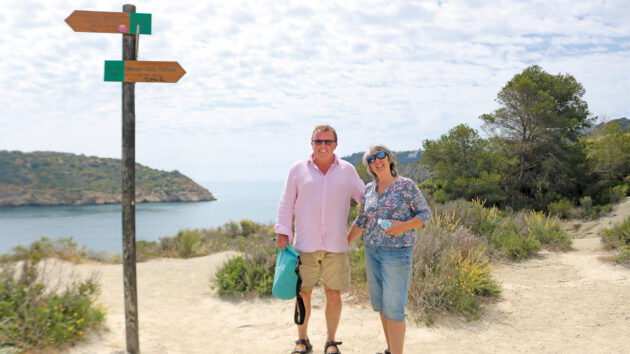
Jon and Ang met Anna in Ibiza
Cat people
My hairdresser has other worries after I share my ‘holiday plans’. ‘Seven years at sea,’ she repeats, ‘they must be running away from something!’ No, I’d concluded, my hosts are going to be OK. ‘They’ve got cats after all,’ I’d told my partner after face-timing them. ‘So, they can’t be that weird. They’re called Batman and Robin – the cats, that is…’
He’d looked at me funny, and on reflection maybe selling up and sailing around the world (twice) with Batman and Robin on board is not much of a litmus test for sanity. But on the plus side they’d kept the cats alive thus far. And anyway, ‘being weird’ wasn’t high up on my ‘avoid’ list. Whereas a sense of humour was also a definite plus.
I know I’m labouring the point, but actually being safe both in terms of the boat and the people, and us all getting on, were my major considerations. Your list may differ – it may start at the boat, for example. And hooking up with people online may not be as daunting to youngsters for whom online dating is the norm.
But for me, this is a complete unknown, so after browsing a few options I signed up with Crewseekers.com – a paid service with some regulation – and arranged video calls with potential skippers for that all-important human connection.
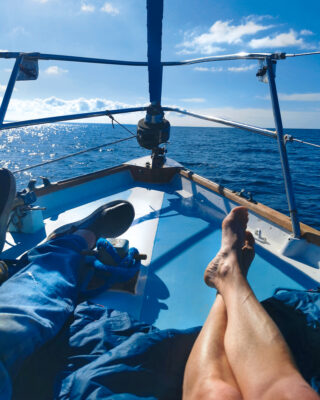
Anna aspires to cruise further in her own Nic 32
Sit-com extra
So here I am in Ibiza, following a treasure map of photos and Google Map screen grabs with a boat circled in red. Twenty-somethings stagger past me in barely-there outfits and freshly tanned skin, searching for somewhere open late on a Monday night. I head to the harbour and glance around.
There’s a couple on a bench with a rucksack and trousers. They look like they’ve already been clubbing – maybe in the 90s – so, they’ve either nailed an old school vibe, or they’re who I’m looking for. ‘Hi’, I offer. There’s a hesitation. Followed by a long pause. People look different online, don’t they?
‘Anna?’ questions the burly, smiley guy. We share relief. And I apologise for having left their phone number at home…duh! Fortunately, they’ve brought their home with them and as I awkwardly climb into the tender, the first of many comedic moments breaks the ice. In fact, Jon and Ang have bucketloads of humour, and by the time I reach my cabin, I already feel a bit like an extra in a sitcom.
Article continues below…
How to sail across the Atlantic and back
Confined to quarters during the pandemic, many sailors are itching to slip their lines and sail for the sun. Elaine…
Cruising in the beautiful Baltic
When I was a young boy, barely having learnt how to swim, I would stand by the sea in my…
For me, another big tick is what they are doing. Jon and Ang have been full-time liveabords for the past seven years. I’m intensely curious. I want to find out why and how and everything in-between. These guys really jumped in at the deep end; sold their B&B and bought Ultima, a 56ft Oyster, as their first boat with very little previous sailing experience. It was Jon’s dream, having been introduced to sailing whilst in the Paras.
Sailing a big boat like this is completely different to my 32ft Nicholson. Ultima is equipped with three electric winches, powered windlass, and an in-mast furling main, making me feel rather redundant. I was expecting to take on a share of the physical side of sailing and have to adjust to using my eyes and button-pressing-fingers, rather than using much strength and feel.
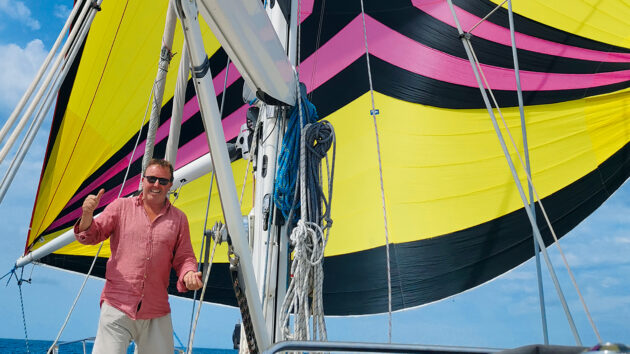
The first passage calmed nerves, and gave Jon a chance to set the spinnaker
A first sail
Our first passage is Ibiza to mainland Spain, a journey of about 55 miles in light winds. I fetch the lure that arrived at my address the previous week – a plastic squid almost as long as my arm with wobbly eyes. Jon and I put out two lines. After a while we decide to try the symmetric spinnaker they were given in exchange for fixing someone’s generator.
Goodie, there is some physical work to be done. We prepare a pole, set autopilot to ‘follow the wind’ and attach the sock to the spinnaker saildrive and I start to winch. ‘Are we nearly there yet?’ I ask after what seems like an hour. ‘No, you’re about halfway,’ Jon chuckles. It’s flipping enormous. How the hell we’re going to get it down again I don’t know. But the speed at which it’s pulling our 33 tonnes along almost matches the wind.
It’s lovely and cool under the solar power-topped cockpit. The sea is sparkling. And, much to my delight, the fish are biting. My second physical challenge of the day is reeling in our supper. Action moves to the beat of James Brown blasting out from Jon’s beloved Radio 2, and the vibe temporarily switches up to Good Morning Vietnam.
The tuna is relatively small, but proves hard work all the same. I’m elated when it hits the deck; a tired, but sadly delicious, muscular body with a rainbow sheen and big eyes. This is not my average Tuesday, but Batman and Robin seem to know the drill and scamper downstairs with Ang to contemplate recipes.

Jon and Ang are not in a rush to get to places. This isn’t just a short holiday for them
Desperate battle
Back on deck, the wind strengthens and it’s time to take the spinnaker down. Jon’s plan is to depower it using the main to ‘steal the wind’. I think this is a Vendee Globe-inspired idea, but it doesn’t go well as we desperately battle to pull the snuffer back down over a spinnaker that refuses to depower, despite releasing the tack and using the main.
Eventually it’s (largely) back in its sock. But with research, we decide that we’d use the ‘letter box method’ – pulling it into the cockpit between the foot of the mainsail and boom – should we need to deploy it again.
Where the wind blows
Another large yacht motors past. ‘They must be on holiday,’ tuts Jon, and I realise the significance: Jon and Ang are not in a rush. They’ve been around the world twice already and literally go where and when the wind blows.
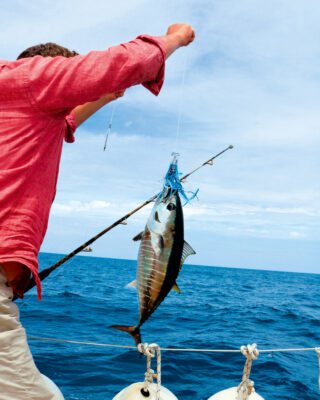
Anna reels in her first tuna
To them, a quiet anchorage somewhere within walking distance of a well-stocked supermarket means their holy trinity of food, sleep and economy, are catered for. My vision of one marina after another – practising knots and manoeuvres is not a reality for this large, heavy, wanderer.
By the first evening, we have something of each other. Jon’s calling me Anna Summers in reference to my lingerie days (I was a lingerie designer), and (in my head at least) I’m calling them Terry and June (look it up kids).
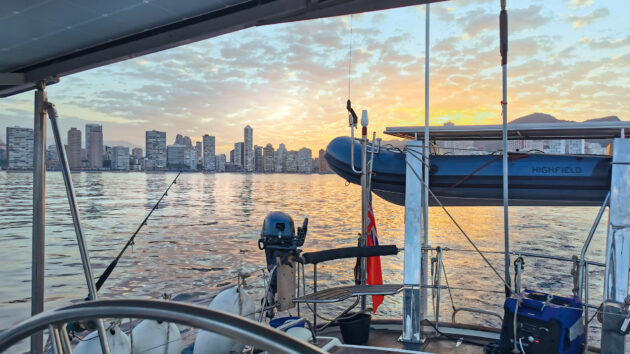
Being afloat is a better way to explore than in a tower block ashore
Taking it all in
Over the week, there are many things that we learn together such as: we should keep the rope on our anchor trip-line as short as possible to avoid it wrapping around the anchor cable; kedging out on eel grass doesn’t work (it’s too slippery); and that the furled mainsail bangs noisily in the mast all night if we don’t kedge out the stern to hold our bow into the swell – forcing us to up-anchor and forfeit a full English and pint in Benidorm.
However, we do make it to the idyllic fishing coves of Javea, before heading to the salt lagoon of Mar Menor and flat water. The entrance to the lagoon is very shallow and we have difficulty working out exactly if and when there is a high water.
We scrape in, hoping to meet up with a boat they had hung out with in the Caribbean five years previously but had not seen since. The warmth and understanding between the couples could only be born of water. Mar Menor is a fantastic place for the five of us to explore.
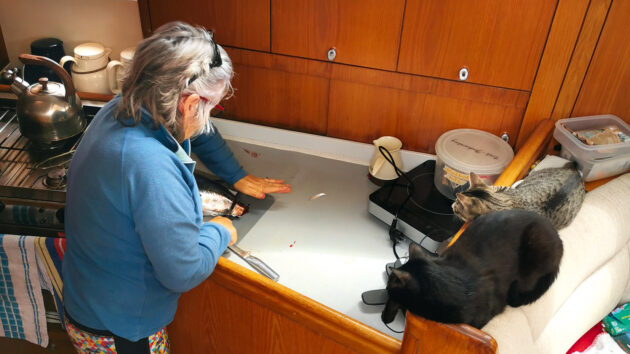
Ang preparing the tuna watched by two hungry cats
Warm delight
It’s a mixture of nature reserve and built-up bits with picture-perfect architecture. Restaurant service is as warm as the weather and at a constant 4m depth, the lagoon is ideal for practising sailing manoeuvres and dinghy driving – much to my delight.
The two guys are both incredibly good at fixing stuff – and it’s a lot of stuff. Hydraulics, watermakers, freezers, hot water system, washing machine, radar, several types of autopilot – nothing is untouched or unfathomed between them.
Coming from a simple boat, I can’t help but be a bit baffled as to whether all of this is necessary. It needs constant maintenance and expense. Doesn’t it make your life more complicated? I ask. I don’t really get an answer to this, except that maybe it would be hard to go seven years without all of these things. And I guess you just wouldn’t have access to these comforts in many of the places you’d want to go.

Luxuries ashore are rare, but this tapas was worth it
But one thing is clear, the liveaboard community really look after each other and love to fix each other’s boats. Jon marvels at Eamon’s space-age electrics system, and Eamon tells me wide-eyed about Jon ‘picking up the generator and then deciding where to put it, it must have been 55 kilos,’ he says. ‘62 with the fuel’, Jon grins.
‘I’ve always got a spanner in my hand,’ complains Caroline, who, when asked about her travels, finds that land-based girlfriends are disappointed to hear the nuts and bolts of it all. ‘They’re after the romance of places not the reality,’ she sighs. Long-term sailing is not like those flashy blogs you see online.
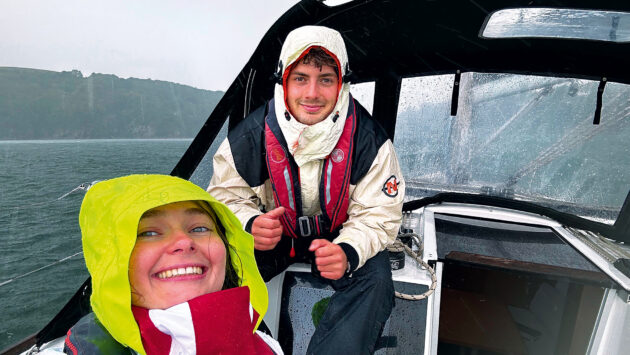
Day-sailing, even in the rain, is a fun way to get afloat
Finding the crew to match you
Consider your criteria
Put together a ‘want’ and ‘avoid’ list. What do you really want to experience? What do you have to offer (it may be skills outside of sailing too, like photography, tech help, ace cook).
Do consider opportunities outside the UK as international travel maybe more practical and affordable than you think. Be honest about your skills and learning objectives and about what kind of people you want to hang out with. Are there any training opportunities? What are the skipper’s qualifications?
It’s fine to dip your toe in gently – or throw yourself in at the deep end. Just think about what would make you feel comfortable or uncomfortable in terms of management style, duties, boat safety, personal attitudes. A video tour of the boat at this point can be useful.
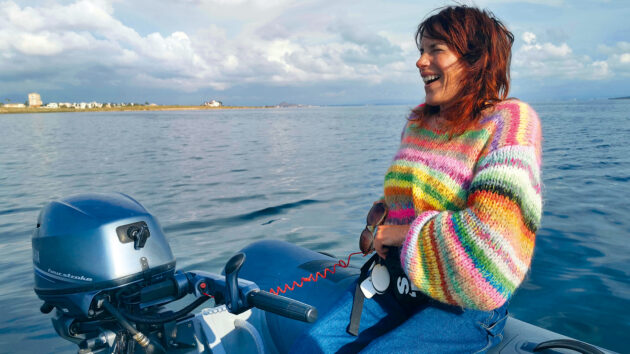
Anna gets to grips with driving the dinghy
Personality fit
Meeting potential crewmates in person is ideal, though online face-to-face is a good alternative. A yacht is a small space in which personalities, feelings and conflicts can become magnified, so the dynamic between you and your skipper is critical, particularly for longer trips.
It’s fun to find out about new people, but does the conversation flow? Are you comfortable about asking awkward questions? Is there transparency in terms of what’s expected of you and what you contribute in return? Do not be afraid to ask about anything that’s important to you. It’s OK to ask more personal questions or dig further into safety, maintenance and competence issues. I asked loads of questions.
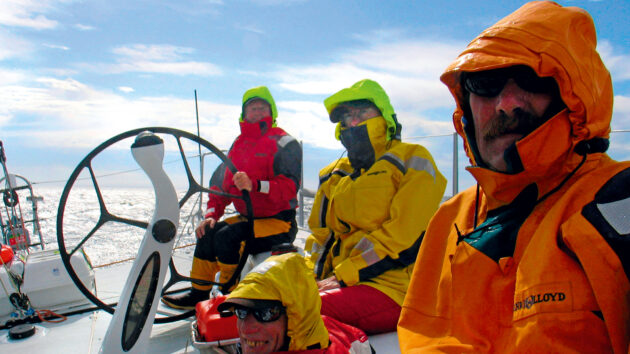
Getting into deliveries is a great way to build miles and experience
Make your own luck in crewing
These considerations may be just as useful to potential skippers as to those thinking about crewing.
Day-sailing
Starting with day-sailing is much easier – it’s likely you can find a boat through friends or your local club. Consider yacht club crew introductions – every skipper who races needs crew who can commit, plus some cruisers want local crew for day/weekend sails. Or become boat buddies and friends of friends – it’s good to swap boats/crew from time to time. Also try charity volunteering at your local club or trust.
For local sailing, a coffee or phone call with a ‘who brings the lunch’ kind of a conversation alongside a few details about your experience is probably enough.
Passage making
For longer passages and time aboard, you may need to cast the net far wider to find your perfect match. Crewseekers or other online platforms are good for longer-distance cruising. For yacht deliveries, sign up with an agency and if you meet their criteria, you will be teamed up with other experienced crew for some serious mile-building on a whole range of boats.
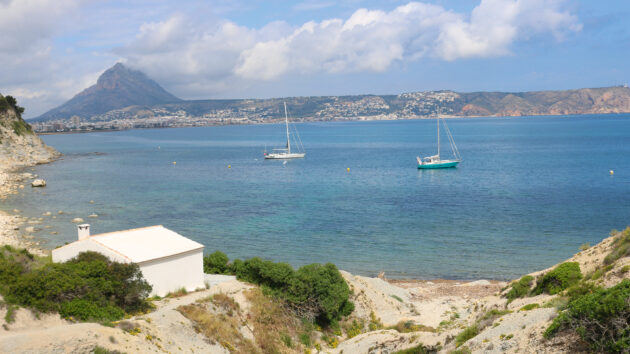
A cool place to hang-out under the solar panels
Why boats need crew
So why have crew I wonder? Well, there seem to be two main reasons for this: company and passage watches. Caroline and Ang agree that family and friends came out in the first year, but that visits dropped off quite quickly. I totally get why Jon and Ang have crew – they love people. Also, it must get a bit intense just the two of them. Even if you love your co-star, you still want to change the script and cast sometimes. Not to mention fresh ideas and conversation that helps keep them connected to land.
‘It is a privilege to live like this,’ Jon states. But like land-living, it has its good days and bad. I sense that my being here also provides purpose for natural hostess Ang (post B&B), as well as sharing some of the cost. I wonder if having like-minds on board also provides some kind of affirmation for their life choice too?
They certainly share it with great kindness and generosity. Stay long enough and you start to become family. The light winds remain and we don’t make it on to Gibraltar. There are some things that you just can’t plan.
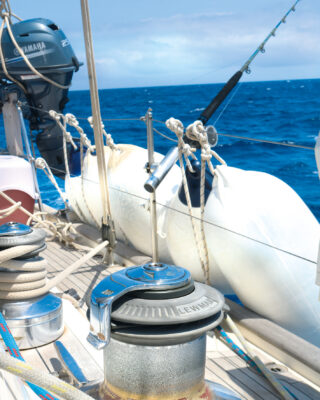
Maintenance is pretty much non-stop for liveaboard cruisers, from winches and outboards to internal systems
Land finale
So it is that we spend our last day together on land. We bus to Cartagena, a fine example of what the Spanish do best with its seamless mix of ultra-modern and old architecture peppered with tapas bars. El Canton serves us mussels, local cheeses and wine. We trot out eventually and make our way to the transport hub. ‘Bye mum and dad,’ is my final cheeky farewell. And we part ways – me towards Murcia and its airport and them back the way we came. I hope they’re gonna be alright without me, I wonder as I head to the hostel I’ve booked. One short train ride back to being a land-dweller. I miss them already.

Anna is keen to try a more ambitious offshore passage than she has done before
What I have learned
So, what did I get out of it? I’d say a huge number of little things that add up to an invaluable insight into distance sailing, bluewater cruising culture, an introduction to the Mediterranean – its tides and weather systems – and working a bigger, powered boat. It was just the gentle introduction to crewing with nice people and a bit of travel that I was hoping for. I also learnt that the financial contribution is a good indication of how much crewing will be required of you.
The more you pay for, the more of a holiday vibe you and your hosts may have. The more they contribute the harder you’ll work. So, if you have skills and really want to use them, you should be looking to pay for your travel but not necessarily a daily contribution (see https://www.crewseekers.net/how-much-should-crew-contribute/). This works both ways and if you are not putting anything in financially, you should be mucking in at every level.
I was lucky to find good people with a similar attitude to sailing and life in general. Now that I’ve done it and understand the process and what I can contribute, I won’t be afraid to pursue further crewing opportunities with travel-only contributions. They’ve already invited me back to crew on this basis – as have their lovely friends Caroline and Eamon who are sailing to the Bahamas this winter. For me, it’s truly opened the door onto a much bigger sailing world full of different boats, people and places. And its available year-round, thanks to budget airlines.
Enjoyed reading this?
A subscription to Yachting Monthly magazine costs around 40% less than the cover price, so you can save money compared to buying single issues.
Print and digital editions are available through Magazines Direct – where you can also find the latest deals.
YM is packed with information to help you get the most from your time on the water.
-
-
- Take your seamanship to the next level with tips, advice and skills from our experts
- Impartial in-depth reviews of the latest yachts and equipment
- Cruising guides to help you reach those dream destinations
-
Follow us on Facebook, Twitter and Instagram.
Note: We may earn a commission when you buy through links on our site, at no extra cost to you. This doesn’t affect our editorial independence.

